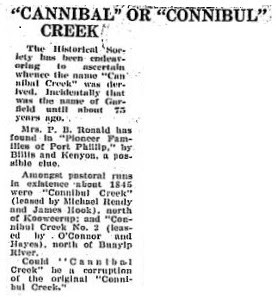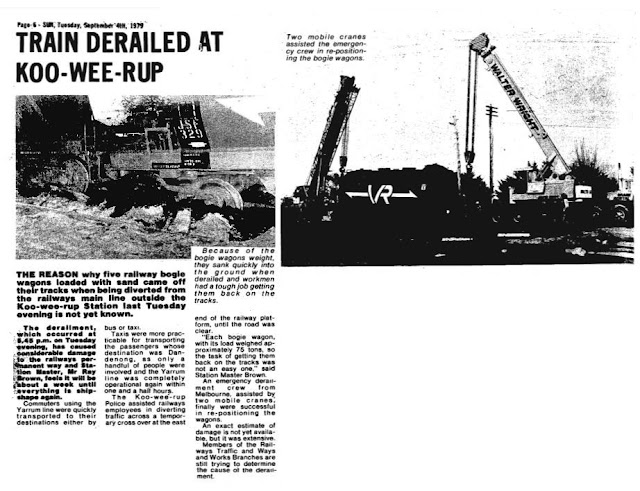Here are some population figures for Koo Wee Rup and the Swamp. We will start with cattle and other livestock.
In November 1840, Samuel Rawson compiled an inventory of the stock on the Yallock Cattle run, which he had operated with Robert Jamieson since the previous year. The property was on the Yallock Creek, and was the first European settlement on the southern edge of the Koo Wee Rup Swamp. The inventory showed that the property had 291 breeding cows, 80 heifers, 199 female calves, 86 fat bullocks, 222 steers, 112 male calves, 6 bulls, 12 working bullocks and 6 horses – 937 animals in total, valued at £7808. (1)
In 1858, when the Yallock Station was owned by William Lyall, the 3000 acres stocked 1200 cattle, 180 horses and 500 sheep. (2) In December 1862, Lyall had 990 ewes, 254 'Homebred' sheep, 148 horses and nine pigs. (3)
The Koo Wee Rup Swamp main drainage works commenced in 1889 and the area was considered ready for settlement in 1893, thus we begin to get some population figures for people. The Ballarat Star reported that in August 1894 there were 295 families on the Swamp, with a population of 1250. (4) However, the Cranbourne & County Herald reported in September 1894 that there were 230 families and a population of 1280. (5) Another set of figures has the 1895 population as 546 settlers of which 348 were children. (6)
In 1896 there were 1887 settlers of which 1171 were children. (7) With that many children two new schools were built – one at Koo Wee Rup North (Five Mile) and the other at Iona, which both opened in July 1894. The Koo Wee Rup North School was 40 ft x 18 ft (13 x 6 metres) and in the 1890s had 106 pupils, which seems like a lot of children for the size of the building. (8)
Moving on to 1898, there were 1669 settlers on the Swamp of which 1068 were children. In 1901: 2192 settlers of which1360 were children; 1904: 2024 settlers with 1424 children. (9)
The earliest population figure for the town of Koo Wee Rup that I can find is from 1920 when there were 500 people; Cranbourne at the same time had a population of 250. (10) Because Koo Wee Rup was the largest town in the Shire of Cranbourne, in 1923 there were discussions about moving the headquarters from Cranbourne to Koo Wee Rup. In support of this move Cr Edward Hill, quoted population figures from the Municipal Directory-
[in 1908] I find under the head of Cranbourne that its population was 200. Koo-wee-rup is mentioned merely - was so small that there is no population given. The 1923 edition, 15 years later, says Cranbourne population is 250, so they have increased 50 in 10 years. Koo-wee-rup's population is 500, and this is the place that they have the effrontery to tell you to your face is a decadent town, and that Cranbourne is going ahead by leaps and bounds. Remember these figures are none of mine; they are taken from the census returns, which cannot lie, or else those that made them are liars. (11)
Cr Hill continued - Now, what other advantage has Koo-wee-rup? First, it is almost the centre of the Shire. Next, the station is in the town. Not a mile away like Cranbourne. Next it is the junction of the McDonald's track and Strezlecki line. Next there are banks built there, not yet to be built, but actually built, and further in the not distant future it will be a port to supply the mammoth steamers that will as assuredly come to Westernport, as night follows day. (12)
The Shire of Cranbourne headquarters never did move to Koo Wee Rup, and nor did it ever become a port. Did Cr Hill think that the steamers would have come up the Main Drain? It seems a bit fanciful.
Around 150 Returned Soldiers were provided with farm blocks under the Soldier Settlement scheme on the Swamp after World War One. Many of these servicemen were placed on the large estates purchased and sub-divided by the Government such as Haglethorns at Rythdale, the Caldermeade Estate and Waori Park at Monomeith. The three parishes of Koo Wee Rup, Koo Wee Rup East and Yallock (essentially the area of the Koo Wee Rup Swamp) had 3,385 acres made available to soldiers; the average allotment size was 54 acres. (13) One of the consequences of this closer settlement was the increase in the number of dairy cattle in the area. It was estimated that the parishes of Koo Wee Rup, Koo Wee Rup East and Yallock had 12,000 dairy cattle in early 1920s. (14)
In 1927 there were three to four hundred Italian potato diggers on the Swamp.. In the same year Italian interests owned over 5500 acres on the Swamp. (15)
The 1930 population figures for Koo Wee Rup and Cranbourne were 500 and 300; 1940 - 650 for Koo Wee Rup and 500 for Cranbourne. It wasn’t until 1960 that the population of the two towns equalised at 800 each. (16)
In November 1884 when the Koo Wee Rup Primary School opened it had 22 students; in 1904 there were 48 pupils; 1926 - 132 students; 1929 - there were 172 students enrolled. It currently has an enrolment of around 350. (17)
The other primary school in Koo Wee Rup, St John the Baptist, opened in August 1936 with 67 pupils on the school register. Their two teachers were Sister Mildred and Sister Padua who travelled by car from the Iona Convent. They currently have just over 200 pupils. (18)When Koo Wee Rup High School opened in 1957 there were 164 students enrolled, with 15 teachers and 3 support staff. In 1967, the school enrolment was 507 and in 1977 it was 618. It now has 1100 students. (19)
The population of Koo Wee Rup today is around 4200 (20), but just image what it might have been if Cr Hill's vision of Koo Wee Rup as a port had ever come to fruition!
Footnotes(1) Gunson, Niel The Good Country: Cranbourne Shire (F.W. Cheshire, 1968) p. 27
(2) Gunson, op. cit. p. 76
(4) Ballarat Star, August 7, 1894, see here.
(5) Roberts, David From Swampland to Farmland: a history of the Koo Wee Rup Flood Protection District (Rural Water Commission, 1985), p. 18












.jpg)




